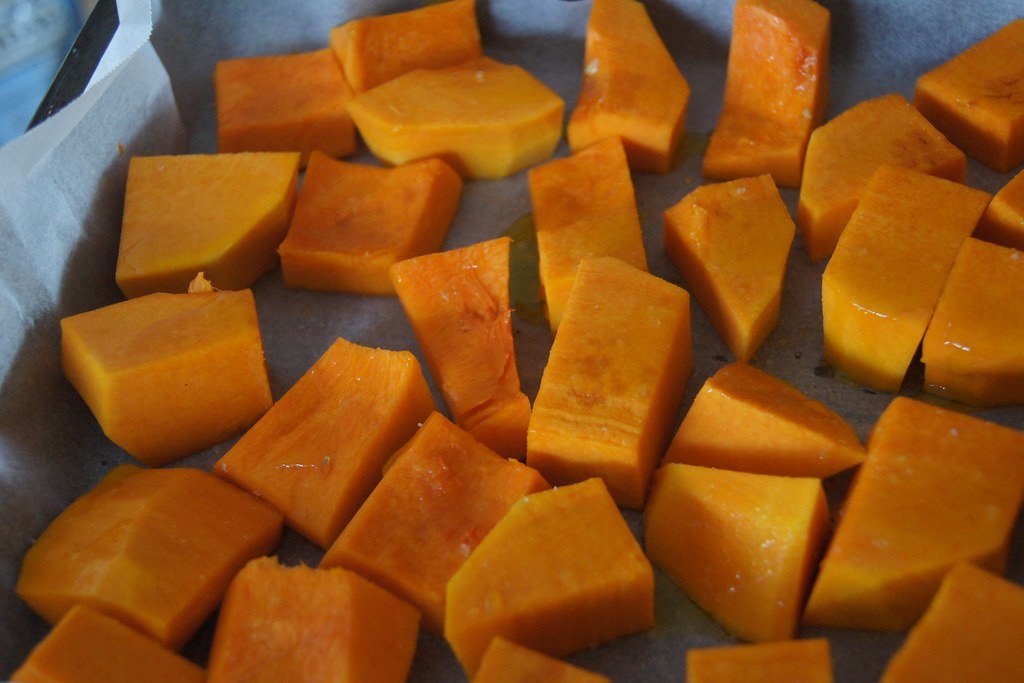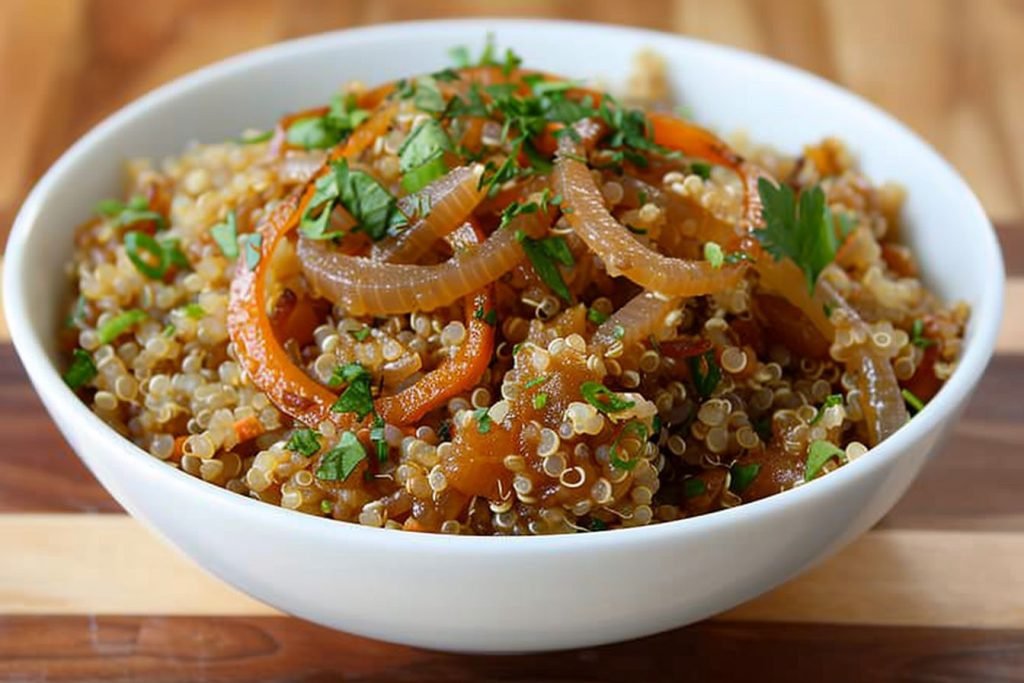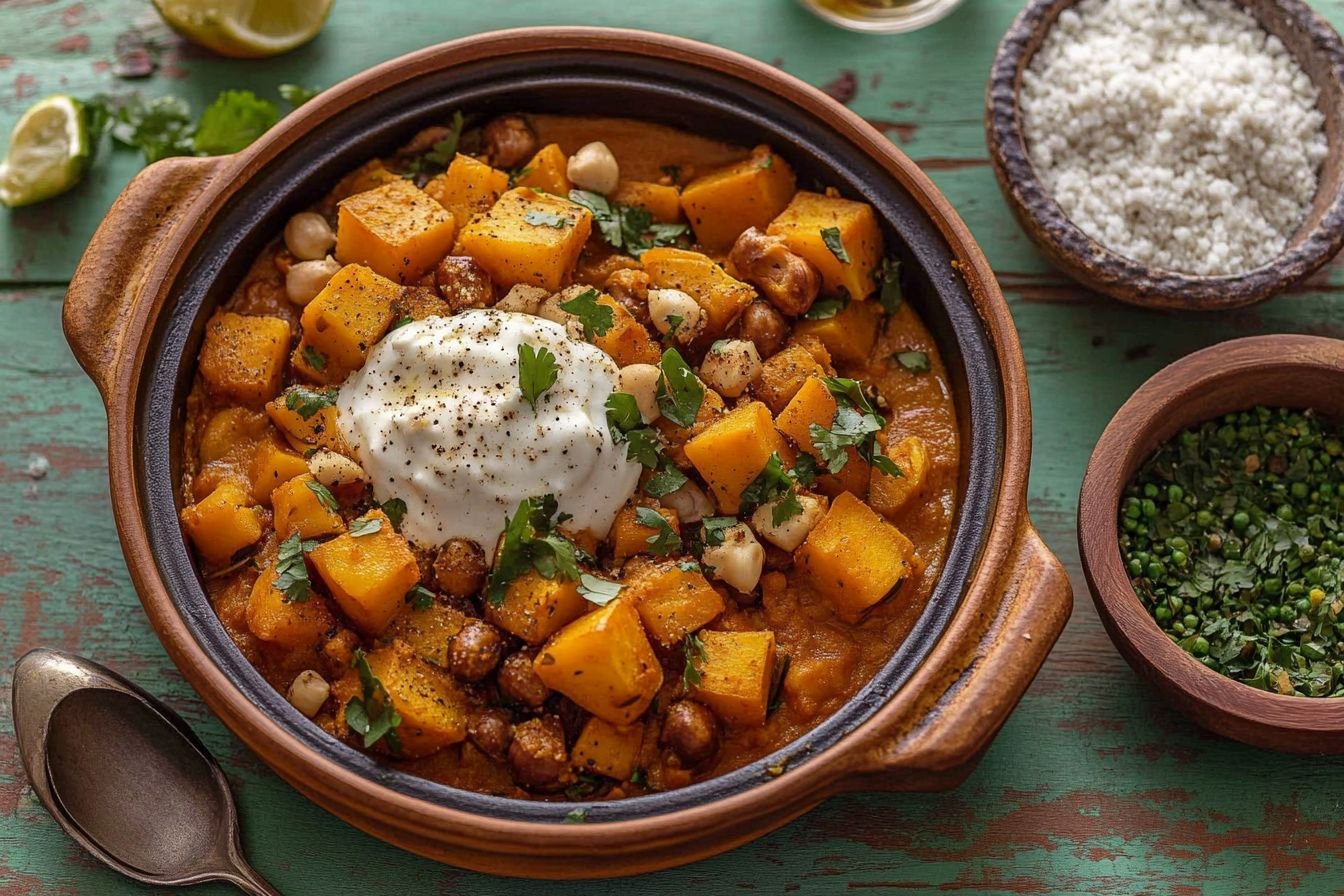I discovered pumpkin tagine while searching for a comforting, healthy dish to warm up my chilly evenings. This Moroccan-inspired stew combines the sweetness of pumpkin with fragrant spices and hearty chickpeas, making it the perfect vegetarian option. The blend of butternut squash, chickpeas, red onion, garlic, vegetable broth, dates, and spices creates a delicious harmony that will tantalize your taste buds.
As I prepared this dish, I realized how simple the ingredients are: butternut squash, chickpeas, red onion, garlic, vegetable broth, dates, Ras El Hanout, cinnamon, rose harissa, raw almonds, cumin seeds, olive oil, Greek yogurt, coriander, and lemon. Each component plays a vital role in building the flavor profile, and the preparation is rewarding and straightforward.
What Is Pumpkin Tagine?
Pumpkin tagine is a delightful North African dish that features pumpkin as the star ingredient.
Traditionally cooked in a tagine pot, it combines spices, vegetables, and sometimes meats or legumes. The cookware ensures even cooking and enhances the flavors.
The dish is known for its rich and aromatic qualities. Cooking low and slow allows the flavors to meld beautifully.
Many variations exist, depending on regional preferences and seasonal ingredients. It can be served with couscous or bread for a hearty meal.
I love how pumpkin tagine offers warmth and comfort, making it perfect for sharing with friends or family during gatherings. It’s a wonderful way to enjoy the flavors of fall all year round.

Ingredients
- ½ butternut squash
- 300 g pre-cooked chickpeas
- 1 red onion
- 2 cloves of garlic
- 350 ml of vegetable broth
- 3 large Medjool dates
- 2 tsp of Ras El Hanout
- 1 tsp of cinnamon
- 1 tsp of rose harissa (optional)
- 4 tbsp of raw almonds
- 1 tsp of cumin seeds
- 2 tbsp of olive oil
- 250 g of Greek yogurt
- 3 tbsp of chopped coriander
- ½ lemon
How to make pumpkin tagine?
- Begin by preparing the butternut squash, ensuring uniform 2 cm cubes. Concurrently, finely slice the allium base and mince the aromatic bulb. If utilizing pre-cooked chickpeas, perform a thorough rinsing procedure. Lastly, the nuts can be lightly caramelized via dry heat in a suitable pan.
- Compose a chilled, emulsified sauce by combining the yogurt with finely chopped coriander and lemon juice, yielding a balanced, acidic counterpoint.
- Introduce a lipid medium to a preheated cooking vessel, maintaining a low thermal setting. Introduce the sliced allium and minced bulb, allowing them to soften under a contained atmosphere for approximately two minutes. This technique ensures optimal aromatic release.
- Subsequently, incorporate the cubed vegetable, dried fruit, and a blend of North African spices, including a chili-based paste. Continue cooking over low heat for an additional two minutes.
- Introduce a liquid stock and whole spice seeds, ensuring thorough incorporation.
- Cover the vessel and allow the mixture to stew for twenty minutes, agitating intermittently to prevent scorching.
- For the accompanying grain, bring the liquid to a boil with a small amount of lipid and salt. Remove from heat, introduce the grain, and allow to hydrate for five minutes under cover.
- Once the primary vegetable is tender, fold in the pre-cooked chickpeas and toasted almonds, ensuring they are heated through.
- Remove the lid, garnish with fresh herbaceous greens, and add a central dollop of the chilled dairy sauce. Serve alongside the hydrated grain.
Nutritional Information
| Nutrient | Amount per Serving |
|---|---|
| Calories | 417 |
| Protein | 19 g |
| Total Fat | 15 g |
| Saturated Fat | 2 g |
| Carbohydrates | 59 g |
| Cholesterol | 3 mg |
| Dietary Fiber | 13 g |
| Sugars | 23 g |
| Sodium | 53 mg |
Serving Suggestions
Accompaniments
When serving pumpkin tagine, I love to pair it with fluffy couscous or quinoa. These grains absorb the sauce beautifully, balancing the dish. Adding toasted almonds or pine nuts on top provides a delightful crunch.
Consider a side of spiced flatbreads for scooping up the tagine. They add an authentic touch. I also enjoy serving a fresh salad with ingredients like cucumber, tomato, and mint for a refreshing contrast. A drizzle of lemon dressing brightens the flavors.
Presentation Tips
For presentation, I often use a large, shallow bowl to display the tagine. This allows the vivid colors to shine. I like to garnish with fresh herbs, such as cilantro or parsley, which add a pop of green.
Serving alongside small bowls of harissa or yogurt gives diners the option to customize their plates. Use colorful tableware for a warm, inviting atmosphere. I also enjoy arranging the dish with slices of lemon or pomegranate seeds to enhance visual appeal.
Storing Leftovers and Reheating
Safe Storage Practices
To keep my pumpkin tagine safe, I use airtight containers. This prevents moisture and air from affecting the dish. I make sure it cools to room temperature before transferring it to the fridge.
I store it in the refrigerator if I plan to eat it within 3 to 4 days. For longer storage, I freeze it in portions. When freezing, I label containers with the date to track freshness.
Thawing should be done in the refrigerator for at least 24 hours before reheating. This method preserves taste and texture, ensuring a satisfying meal later.
Reheating for Best Flavor
When reheating pumpkin tagine, I prefer to use a stove or microwave, depending on the time. If I choose the stovetop, I add a splash of water or vegetable broth to keep it moist.
I heat it over low to medium heat, stirring occasionally until it’s hot throughout. This gradually warms the dish without losing flavor.
If I’m using a microwave, I cover the bowl loosely to trap steam, which helps heat evenly. I typically check it in 30-second intervals to avoid overheating.
These methods help maintain the rich flavors and comforting qualities of the tagine, so it tastes just as delicious as the first time.
Conclusion
Making pumpkin tagine has been a delightful journey through flavors and textures. I appreciate how versatile pumpkin can be, bringing a comforting sweetness to the dish.
Using spices like cinnamon, cumin, and coriander enhances the dish’s warmth. Each ingredient plays a role in creating a balanced meal that feels both hearty and nourishing.
I love serving this tagine with couscous or flatbread. These sides soak up the rich sauce perfectly, making for a satisfying meal.
Using fresh herbs like cilantro or parsley adds a refreshing touch. They brighten the dish and elevate the flavors even more.
Pumpkin tagine is not only delicious but also showcases the beauty of seasonal cooking. It’s a perfect way to celebrate fall’s bounty while enjoying a dish that warms the heart.
As mentioned before, quinoa is one of the best accompaniments for this dish.
Get this mujadara with quinoa recipe now (by clicking the image below):





